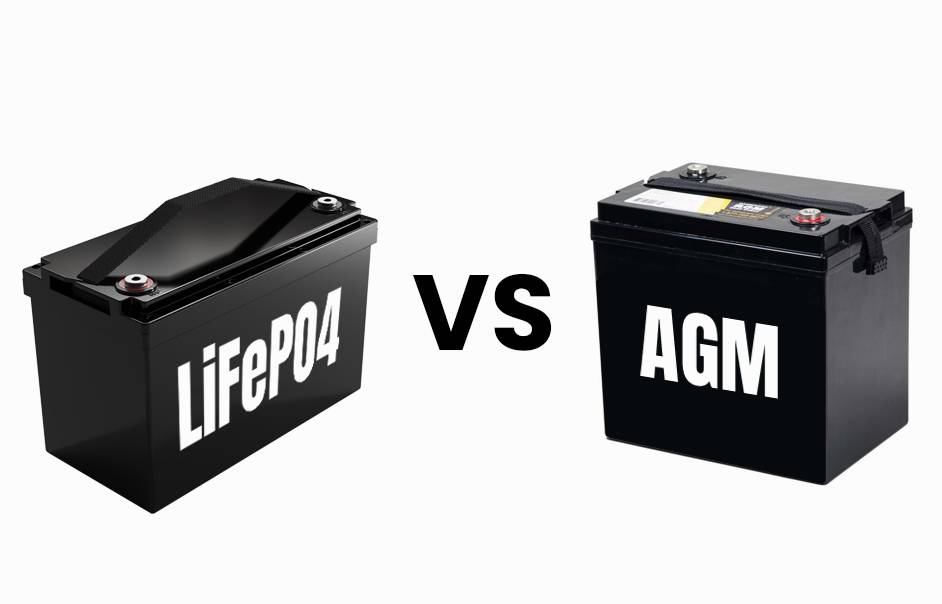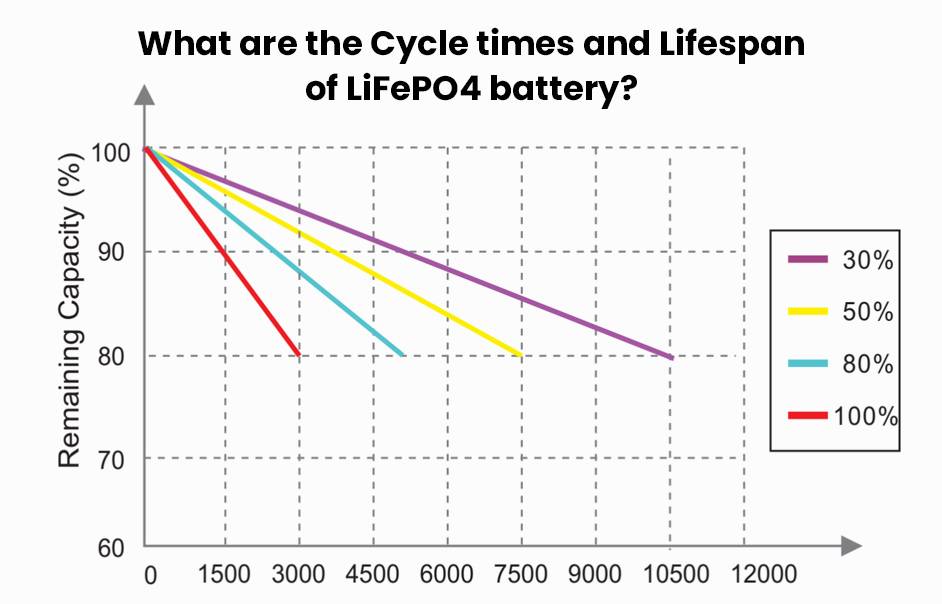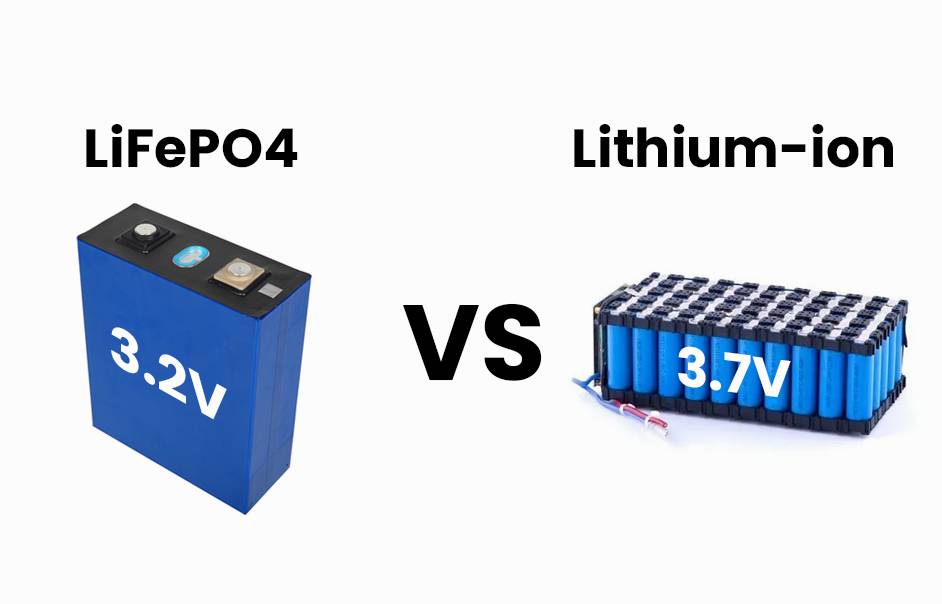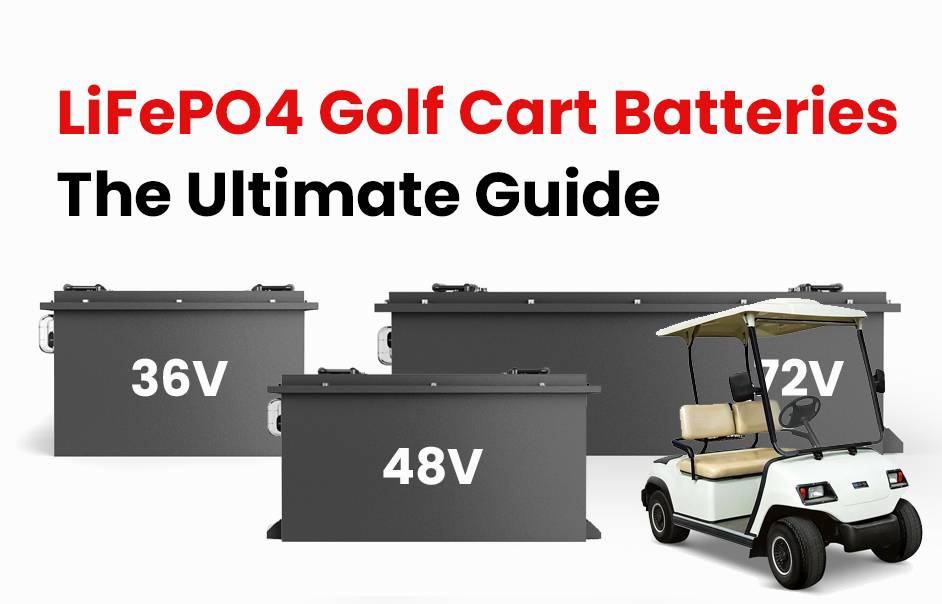- Lithium Golf Cart Battery
- Forklift Lithium Battery
-
48V
- 48V 210Ah
- 48V 300Ah
- 48V 420Ah (949 x 349 x 569 mm)
- 48V 420Ah (950 x 421 x 450 mm)
- 48V 456Ah
- 48V 460Ah (830 x 630 x 590 mm)
- 48V 460Ah (950 x 421 x 450 mm)
- 48V 460Ah (800 x 630 x 600 mm)
- 48V 460Ah (820 x 660 x 470 mm)
- 48V 500Ah
- 48V 560Ah (810 x 630 x 600 mm)
- 48V 560Ah (950 x 592 x 450 mm)
- 48V 600Ah
- 48V 630Ah
-
48V
- 12V Lithium Battery
12V 150Ah Lithium RV Battery
Bluetooth App | BCI Group 31
LiFePO4 Lithium
Discharge Temperature -20°C ~ 65°C
Fast Charger 14.6V 50A
Solar MPPT Charging - 24V Lithium Battery
- 36V Lithium Battery
- 48V Lithium Battery
-
48V LiFePO4 Battery
- 48V 50Ah
- 48V 50Ah (for Golf Carts)
- 48V 60Ah (8D)
- 48V 100Ah (8D)
- 48V 100Ah
- 48V 100Ah (Discharge 100A for Golf Carts)
- 48V 100Ah (Discharge 150A for Golf Carts)
- 48V 100Ah (Discharge 200A for Golf Carts)
- 48V 150Ah (for Golf Carts)
- 48V 160Ah (Discharge 100A for Golf Carts)
- 48V 160Ah (Discharge 160A for Golf Carts)
-
48V LiFePO4 Battery
- 60V Lithium Battery
-
60V LiFePO4 Battery
- 60V 20Ah
- 60V 30Ah
- 60V 50Ah
- 60V 50Ah (Small Size / Side Terminal)
- 60V 100Ah (for Electric Motocycle, Electric Scooter, LSV, AGV)
- 60V 100Ah (for Forklift, AGV, Electric Scooter, Sweeper)
- 60V 150Ah (E-Motocycle / E-Scooter / E-Tricycle / Tour LSV)
- 60V 200Ah (for Forklift, AGV, Electric Scooter, Sweeper)
-
60V LiFePO4 Battery
- 72V~96V Lithium Battery
- Rack-mounted Lithium Battery
- E-Bike Battery
- All-in-One Home-ESS
- Wall-mount Battery ESS
-
Home-ESS Lithium Battery PowerWall
- 24V 100Ah 2.4kWh PW24100-S PowerWall
- 48V 50Ah 2.4kWh PW4850-S PowerWall
- 48V 50Ah 2.56kWh PW5150-S PowerWall
- 48V 100Ah 5.12kWh PW51100-F PowerWall (IP65)
- 48V 100Ah 5.12kWh PW51100-S PowerWall
- 48V 100Ah 5.12kWh PW51100-H PowerWall
- 48V 200Ah 10kWh PW51200-H PowerWall
- 48V 300Ah 15kWh PW51300-H PowerWall
PowerWall 51.2V 100Ah LiFePO4 Lithium Battery
Highly popular in Asia and Eastern Europe.
CE Certification | Home-ESS -
Home-ESS Lithium Battery PowerWall
- Portable Power Stations
NCM vs LiFePO4 battery, All You Need to Know

Ternary lithium batteries, recognized for their global usage and safety measures, feature a crucial protection plate. This plate serves to manage elements like overcharging and overheating, ensuring their secure application. Widely embraced for small high-power batteries worldwide, these batteries find a prominent place in high-end Tesla cars. While continuous safety enhancements have been implemented, this introduction aims to address common curiosities about ternary lithium batteries, reassuring readers that adherence to instructions guarantees a safe and reliable experience.
What is NCM Battery?
NCM battery, also known as the “Ternary lithium battery,” incorporates nickel, cobalt, and manganese in its cathode composition. Increased nickel levels pose challenges by making Li+ removal more difficult, leading to reduced capacity and cycling. Higher nickel content results in an unstable Ni3+ proportion, intensifying reactions with moisture and CO2, thereby impacting overall performance. The term “ternary” originates from the three cathode metals: nickel (Ni), cobalt (Co), and manganese (Mn). Varied ratios, such as 1:1:1, 5:2:3, and 8:1:1, create distinct compounds, forming the basis for the fixed compound materials in Ternary lithium batteries.
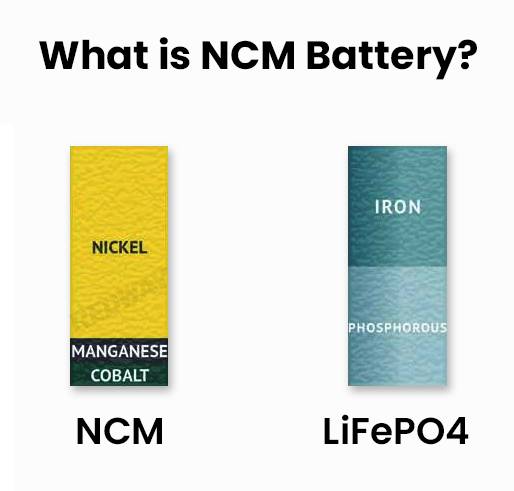
Why we use Ni, Co and Mn in ternary lithium battery ?
Nickel (Ni) exhibits low reactivity at room temperature, hindering oxidation in air. The presence of Ni ions contributes to a higher volumetric energy density.
Cobalt (Co) remains stable in humid air and is unreactive with water at room temperature. Despite its relatively high cost, the laminar structure of the material enhances stability, reduces impedance values, and improves conductivity and cycling performance through the presence of Co ions.
Manganese (Mn) is inherently stable, resistant to oxidation or reduction. The inclusion of Mn ions enhances material safety and stability.
Safety Concerns with Ternary Lithium Batteries
Ternary lithium batteries, while widely used, pose certain safety concerns. Understanding and addressing these issues is essential for responsible usage.
-
Overheating and Fires:
- Ternary lithium batteries are prone to overheating and fires, particularly when damaged or mishandled.
- Proper handling practices and adherence to safety guidelines are crucial to prevent incidents of overheating and fires.
-
Comparison with LiFePO4 Batteries:
- Ternary lithium batteries have a lower thermal runaway temperature compared to lithium iron phosphate (LiFePO4) batteries.
- This makes them more susceptible to catching fire at high temperatures, emphasizing the need for cautious use.
-
Charging Guidelines:
- Charging ternary lithium batteries requires strict adherence to specific guidelines, including using a charger designed for lithium-ion batteries.
- Monitoring the charging process, avoiding overcharging, and following manufacturer specifications are essential safety measures.
Conclusion: Understanding and addressing these safety concerns ensures responsible use of ternary lithium batteries, minimizing risks and promoting safe utilization in various applications.
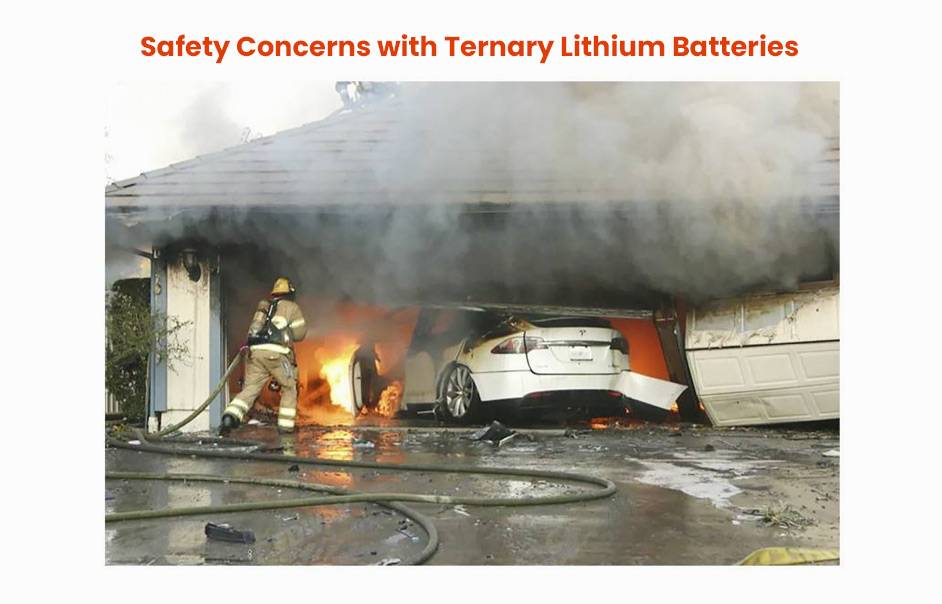
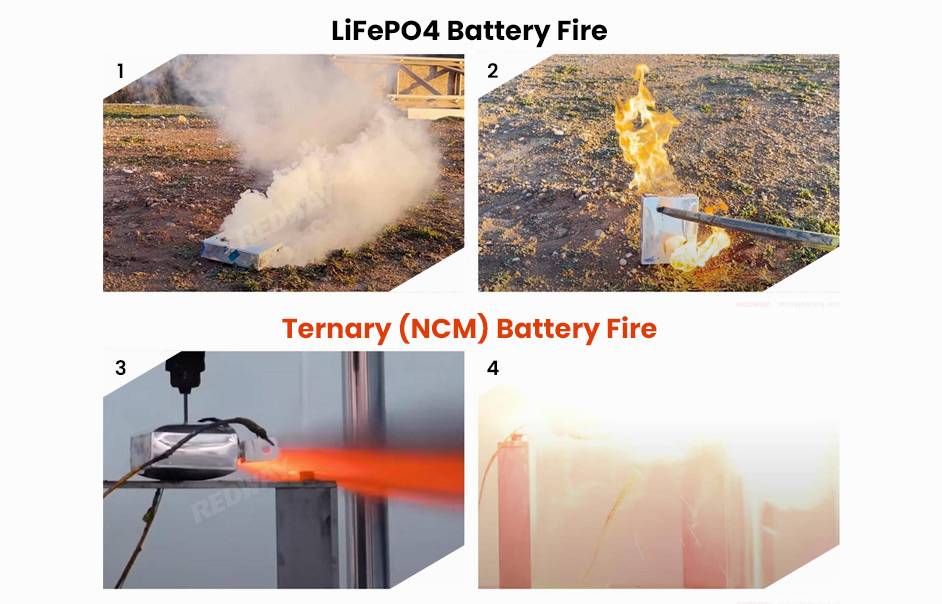
How to charge Ternary Lithium Battery?
Charging a ternary lithium battery, also known as a lithium-ion battery with a ternary cathode, requires careful adherence to specific guidelines. Follow these steps to ensure safe and efficient charging.
-
Choose the Right Charger:
- Select a charger designed explicitly for lithium-ion batteries and compatible with your ternary lithium battery’s voltage and capacity.
- Using the correct charger prevents damage and ensures safety during the charging process.
-
Check Battery Specifications:
- Review the manufacturer’s guidelines or datasheet for your ternary lithium battery.
- Note the recommended voltage range, charging current, and any specific instructions provided by the manufacturer.
-
Prepare the Charging Environment:
- Charge the battery in a well-ventilated area with a stable surface, away from flammable materials.
- Avoid extreme temperatures, direct sunlight, or exposure to moisture during charging.
-
Connect the Charger:
- Securely connect the charger’s positive (+) and negative (-) terminals to the corresponding battery terminals.
- Ensure a proper connection to prevent loose or intermittent contacts.
-
Set the Charging Parameters:
- Adjust the charger settings based on the battery specifications.
- Set the charging voltage and current as recommended by the manufacturer.
-
Monitor the Charging Process:
- Keep an eye on the charging process and check the battery temperature periodically if possible.
- Charger indicators or displays can show the charging status or progress.
-
Charge to Full Capacity:
- Allow the battery to charge until it reaches its full capacity.
- Avoid overcharging to prevent reduced battery life and potential safety hazards.
-
Disconnect the Charger:
- Once fully charged, disconnect the charger from the battery terminals.
- Safely unplug the charger from the power source.
Conclusion: While these steps provide general guidance, always refer to the specific instructions and guidelines provided by the ternary lithium battery manufacturer for safe and optimal charging of your particular battery model.
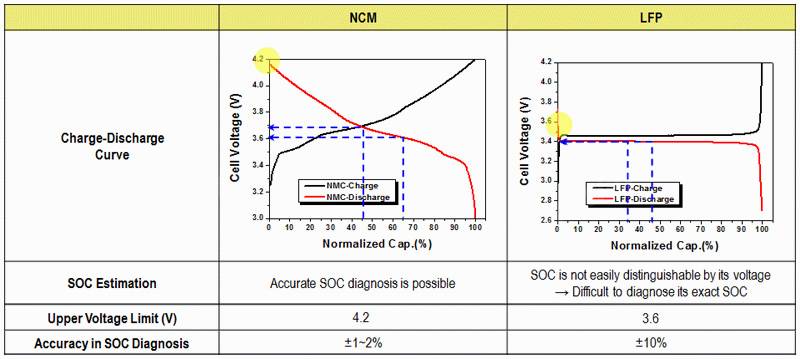
How to store Ternary (NCM) lithium battery?
Ensuring the proper storage of ternary lithium batteries is crucial for maintaining their performance, safety, and longevity. Follow these guidelines to store your batteries effectively.
-
Charge the Battery:
- Charge the battery to around 50-60% of its capacity before storage to prevent over-discharge and minimize stress on the battery.
-
Temperature and Humidity:
- Store batteries in a cool and dry environment, avoiding extreme temperatures that can impact performance.
- Aim for a storage temperature range of 15°C25°C (59°F77°F) and humidity levels below 50%.
-
Avoid Direct Sunlight:
- Keep batteries away from direct sunlight to prevent heat and UV radiation exposure, which can degrade performance and pose safety risks.
-
Battery Enclosure:
- Store batteries in a non-conductive and non-metallic container to prevent accidental short-circuits and physical damage.
-
Ventilation:
- Ensure proper ventilation in the storage area, especially when storing multiple batteries, to prevent the accumulation of flammable gases.
-
Separate Storage:
- If storing multiple batteries, keep them individually or use insulating material to prevent contact and potential short-circuiting.
-
Regular Check-ups:
- Periodically inspect stored batteries for damage, leakage, or swelling.
- Handle any damaged batteries with care and dispose of them following recycling guidelines.
-
Recharge:
- If batteries have been in storage for an extended period, recharge them to the appropriate voltage level before use to ensure optimal performance and safety.
Conclusion: Follow these guidelines and refer to the manufacturer’s recommendations for specific requirements related to storing ternary lithium batteries. By doing so, you can maintain the performance and safety of your batteries during storage, ensuring they are ready for use when needed.
What’s Lithium Iron Phosphate (LiFePO4) Battery?
Lithium iron phosphate batteries use lithium iron phosphate as their cathode material, making them more stable and safer than ternary lithium batteries. The P-O chemical bond of lithium iron phosphate is relatively stable, decomposing only at very high temperatures of 700°C~800°C. Even if the battery is deformed or damaged, oxygen molecules will not be released, preventing violent combustion. LiFePO4 battery can withstand high temperatures of 60°C.。
Safety Advantages of Lithium Iron Phosphate Batteries
LFP batteries offer several safety advantages over ternary lithium batteries. They are less prone to overheating and catching fire, making them a safer choice for a wide range of applications. LFP batteries have a higher thermal runaway temperature, which means they can withstand higher temperatures without catching fire. They are also more resistant to physical damage due to the steel encapsulation of the cells, making them more durable than ternary lithium batteries. Lastly, LFP batteries have a longer lifespan and are more stable, leading to fewer capacity losses with each charge/discharge cycle.
Applications for Lithium Iron Phosphate Batteries
Due to their safety and durability, LFP batteries are increasingly being used in applications that require a high level of safety, such as electric vehicles, cordless tools, and medical devices. LFP batteries are less likely to overheat or be damaged by physical contact, making them a more reliable choice in high-drain applications.
NCM battery vs LiFePO4 battery
Ternary lithium batteries (NCM) and lithium iron phosphate (LiFePO4) batteries are two different types of lithium-ion batteries, each with its own characteristics and advantages.
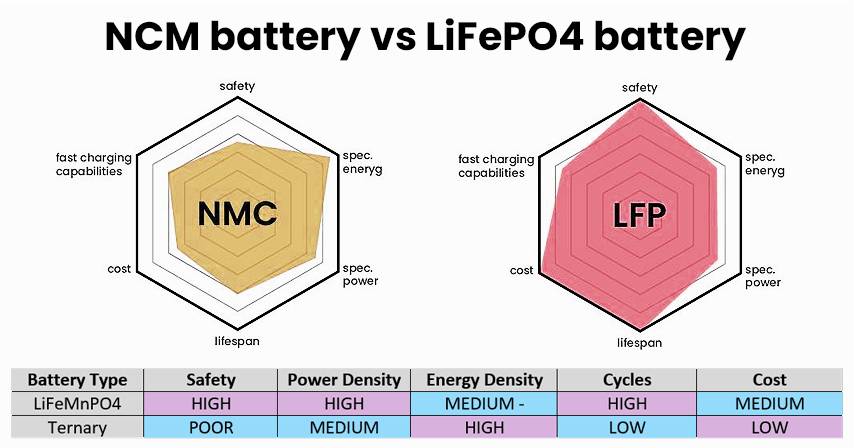
Tesla electric vehicle (EV) and NMC batteries
Tesla’s success in the electric vehicle (EV) industry is fueled by their groundbreaking use of ternary lithium batteries, specifically NMC (nickel-manganese-cobalt) batteries, in the Model series EVs. Here are three key reasons behind the prominence of these advanced batteries in Tesla’s innovation:

-
Cutting-Edge Battery Technology:
- Tesla stands out by pushing the boundaries of battery technology.
- Ternary lithium batteries, combining nickel, manganese, and cobalt, showcase innovation in the heart of Tesla’s Model series EVs.
-
High Energy Density and Stability:
- Ternary lithium batteries provide Tesla vehicles with remarkable energy density, ensuring extended range capabilities.
- The incorporation of nickel, manganese, and cobalt guarantees both high energy density and stability during operation, contributing to a reliable driving experience.
-
Enhanced Safety Measures:
- Safety is a top priority for Tesla, and ternary lithium batteries play a crucial role.
- These batteries exhibit enhanced thermal stability, reducing the risk of overheating or fires during extreme conditions, ensuring a secure driving environment.
In summary, Tesla’s reliance on ternary lithium batteries reflects their commitment to cutting-edge technology, improved performance, and elevated safety standards in the electric vehicle industry.
FAQs
Where can you find latest LiFePO4 and NCM batteries?
Looking for the latest LiFePO4 and NCM batteries? Check out reputable suppliers like Coremax-Tech, EV Lithium, Battery Finds, Seplos Technology, and LiFePO4-Battery. These websites offer a wide range of high-quality batteries for various applications. Whether you need LiFePO4 or NCM batteries, these suppliers have the latest options to meet your requirements.
What are the operational differences between LiFePO4 and NMC batteries?
Looking for the operational differences between LiFePO4 and NMC batteries? In terms of voltage delivery, lithium NMC batteries outperform LiFePO4 batteries, with an average voltage output of about 3.7V compared to 3.2V for LiFePO4. This higher voltage makes lithium NMC batteries better suited for high-power output applications like electric vehicles. Additionally, NMC batteries use a liquid electrolyte, while LiFePO4 batteries use a solid polymer electrolyte. These operational differences impact the performance and characteristics of the batteries in different applications.
How do initial costs of LiFePO4 cells compare to NMC cells?
Comparing the initial costs of LiFePO4 and NMC cells? LiFePO4 batteries have a lower material cost, making them about 20-30% cheaper per kWh compared to NMC batteries. This cost difference is primarily due to the reduced need for rare earth minerals in LiFePO4 construction. If you’re looking for a more affordable option, LiFePO4 cells offer a cost-effective solution without compromising performance.
How do LiFePO4 and lithium-ion charge-discharge curves compare?
Comparing the charge-discharge curves of LiFePO4 and lithium-ion batteries? LiFePO4 batteries have a relatively flat discharge curve, maintaining a stable voltage from around 99% to 20% capacity. This flat curve allows for consistent power output over a longer period. In contrast, lithium-ion batteries exhibit a curved discharge curve, where the voltage gradually decreases as the battery discharges. These voltage behaviors impact the performance and suitability of the batteries in various applications.
What are the operational differences between LiFePO4 and NMC lithium-ion batteries?
Curious about the advantages and disadvantages of LiFePO4 batteries? LiFePO4 batteries offer many advantages, such as high energy density, long lifespan, and safety features. They have a lower risk of thermal runaway and are more stable compared to other lithium-ion chemistries. However, LiFePO4 batteries also have some drawbacks, including limited energy density, higher cost, slower charging speed, lower discharge rate, and a limited temperature range. These factors should be considered when deciding on the suitability of LiFePO4 batteries for your specific needs.
More FAQs:
How can battery performance be made transparent?
Battery performance can be made transparent by implementing real-time battery diagnostics that provide accurate insights into the battery’s health and state-of-charge. By leveraging advanced monitoring systems and technologies, such as smart sensors and data analytics, it is possible to track battery performance metrics continuously and provide users with crucial information regarding the battery’s status and anticipated lifespan. Additionally, developing user-friendly interfaces and communication tools that display battery diagnostics clearly and intuitively can help make battery performance transparent to consumers and operators. Overall, enhancing transparency in battery performance involves integrating proactive monitoring solutions that enable timely interventions and informed decision-making to optimize battery usage and prolong its lifespan.
What are the advantages and specifications of Lithium Titanate (Li2TiO3) batteries?
Lithium Titanate (Li2TiO3) batteries offer several advantages compared to conventional Li-ion batteries with graphite anodes. One key advantage is the zero-strain property of Li-titanate, which helps prevent issues such as lithium plating and the formation of SEI films during fast charging and charging at low temperatures. These batteries also demonstrate superior thermal stability under high temperatures when compared to other Li-ion systems.

Although Li-titanate batteries have a relatively low specific energy of 65Wh/kg, similar to that of NiCd batteries, they have the benefit of charging to 2.80V/cell and reaching the end of discharge at 1.80V/cell. This specification allows for reliable performance within these voltage ranges.
Li-titanate batteries are known for being more expensive than other types of batteries; however, they are commonly used in applications requiring high performance and durability. Some typical uses of Li-titanate batteries include electric powertrains, uninterruptible power supplies (UPS), and solar-powered street lighting systems.
How have advancements in materials and additives improved the performance of NMC batteries in recent years?
Advancements in materials and additives have significantly enhanced the performance of nickel-manganese-cobalt (NMC) batteries in recent years. By combining nickel and manganese, NMC batteries have seen notable improvements, allowing for higher charging voltages of up to 4.4V per cell, which boosts the battery’s capacity. The utilization of new electrolytes and additives has played a crucial role in achieving these advancements. This cathode combination exhibits excellent overall performance and particularly excels in specific energy metrics.
Furthermore, the ability to blend nickel, manganese, and cobalt in varying proportions has expanded the applications of NMC batteries across diverse sectors, including automotive and energy storage systems. This versatility enables the customization of NMC batteries to suit a wide range of requirements, especially those necessitating frequent cycling. Additionally, the economic feasibility of constructing NMC-blended Li-ion systems underscores the positive impact of these advancements, as they not only enhance performance but also provide a cost-effective solution for various industries.
What are the typical applications and market trends for these lithium-ion battery chemistries?
These lithium-ion battery chemistries find a variety of typical applications and exhibit certain market trends. They are known for offering high power with less capacity, while also being considered safer compared to other lithium-ion options such as Li-cobalt. A common practice is to combine these chemistries with NMC to enhance performance. They have historically been less in demand and shown limited growth potential. NMC chemistry is primarily used in power tools, e-bikes, and other electric powertrains. It stands out as the preferred battery for electric vehicles due to its combination of high capacity, high power, and low self-heating rate. It serves as a Hybrid Cell and is increasingly becoming the top choice for various applications, leading to a growing market share.
What are the key considerations for thermal runaway in these different battery types?
Considerations for thermal runaway in lithium-ion batteries vary depending on the battery type. Lithium Manganese Oxide (LMO) batteries tend to experience thermal runaway around 250°C, especially under high charge levels. In contrast, Lithium Nickel Manganese Cobalt Oxide (NMC) batteries have a lower threshold for thermal runaway at approximately 210°C. On the other hand, Lithium Iron Phosphate (LiFePO4) batteries are recognized for their superior safety features, as they exhibit a higher resilience to misuse and are less prone to thermal runaway events when compared to other lithium-ion battery systems. These differences in thermal runaway characteristics underscore the importance of understanding the unique properties and thresholds of each battery type to mitigate potential risks associated with overheating.
How does the charge and discharge behavior differ between LMO, NMC, and LiFePO4 batteries?
Lithium Manganese Oxide (LMO) batteries typically charge to 4.20V and discharge at 2.50V with specific charge and discharge rates. In comparison, Lithium Nickel Manganese Cobalt Oxide (NMC) batteries have different charge voltages and discharge characteristics. Lastly, Lithium Iron Phosphate (LiFePO4) batteries exhibit distinct charge and discharge behaviors compared to both LMO and NMC batteries.
What is the structure and composition of NMC batteries?
NMC batteries, short for nickel-manganese-cobalt batteries, are a type of lithium-ion battery known for their successful composition. The structure of NMC batteries typically consists of a cathode combination of nickel, manganese, and cobalt in varying proportions. This combination is often denoted as 1-1-1, indicating equal parts nickel, manganese, and cobalt. Cobalt plays a crucial role in stabilizing nickel, which is known for its high energy density as an active material in the battery.
To optimize performance while reducing reliance on cobalt, battery manufacturers have developed alternative compositions such as NCM532, which comprises 5 parts nickel, 3 parts cobalt, and 2 parts manganese. Other variations include NMC622 and NMC811, each with its specific ratios of nickel, manganese, and cobalt. These variations offer different trade-offs between performance and the use of cobalt, allowing manufacturers to tailor NMC batteries to meet specific requirements for energy density, stability, and overall battery performance.
How do NMC and Li-phosphate batteries compare in terms of voltage, specific energy, and cycle life?
NMC batteries typically have a higher nominal voltage range and specific energy capacity compared to Li-phosphate batteries. This translates to improved performance in terms of providing higher operating voltages and greater specific energy, which can influence the overall efficiency and power output of the battery system. However, Li-phosphate batteries are known for their good electrochemical performance, long cycle life, and high current rating. Despite having a lower nominal voltage, Li-phosphate batteries offer advantages such as longevity and robust performance under varying current loads. Additionally, while NMC batteries exhibit a wide operating voltage range and specific energy capacity, Li-phosphate batteries are favored for their stable and enduring cycle life, making them a reliable choice for applications requiring longevity and consistent performance over multiple charging cycles.
What are the characteristics of Lithium Manganese Oxide (LMO)?
Lithium Manganese Oxide (LMO) is a cathode material with a spinel structure, commonly known as LiMn2O4, and has been in use since 1996. Its nominal voltage is around 3.70V (3.80V), with an operating range typically between 3.0V and 4.2V per cell. LMO has a specific energy capacity ranging from 100 to 150Wh/kg. When charging, the typical charge rate is between 0.7 and 1C, with a maximum of 3C, reaching up to 4.20V in most cells. It is crucial to turn off the charge when the current saturates at 0.05C.
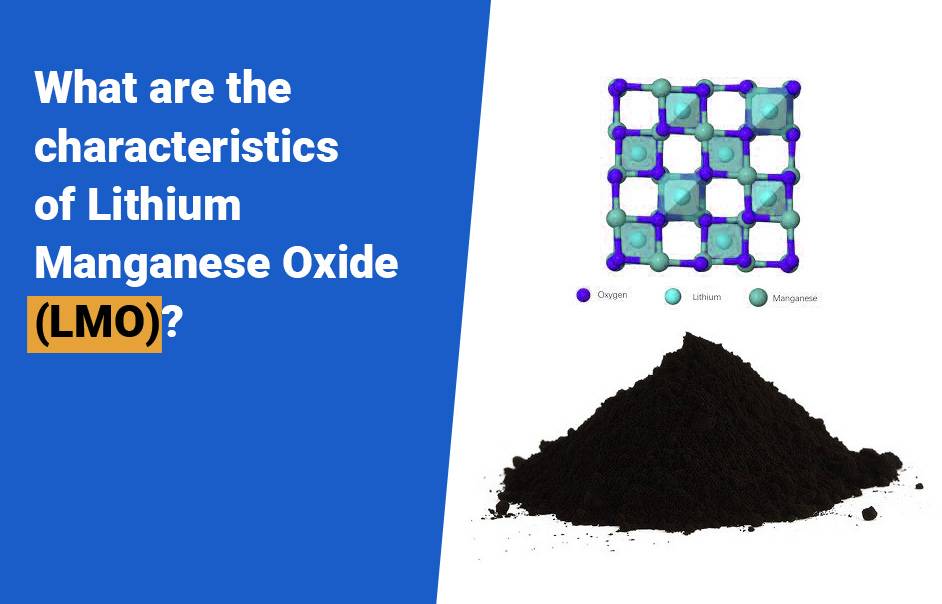
During discharge, LMO can handle rates of 1C; however, some cells can manage up to 10C, with a pulse environment allowing for bursts of up to 30C for very short durations (5 seconds). The discharge cutoff voltage is typically set at 2.50V. The cycle life of LMO is in the range of 300 to 700 cycles and is influenced by factors such as the depth of discharge and temperature. Thermal runaway, where the battery temperature increases uncontrollably, usually occurs around 250°C (482°F) and can be triggered by high charging rates.
LMO finds applications in power tools, medical devices, and electric powertrains. In recent years, LMO has been considered to have high power capabilities but lower capacity compared to other materials like Li-cobalt. To enhance performance, LMO is often combined with materials like NMC. While LMO remains strong in certain applications, it is noted that its growth potential may be limited.
What are the trends in Lithium-ion battery research and development towards improving performance, safety, and longevity for consumer and industrial applications?
In current Lithium-ion battery research and development, a key focus is on enhancing performance, safety, and longevity for both consumer and industrial applications. Researchers are exploring various approaches such as combining lithium-manganese with materials like cobalt, nickel, manganese, and aluminum in the cathode to improve battery efficiency. Additionally, the addition of silicon in small amounts to the anode has been considered to boost capacity by 25%. However, it is noted that while this enhancement increases capacity, it may impact the battery’s cycle life due to mechanical stress as silicon expands and contracts during charge and discharge cycles.
Moreover, the selection of active metals like cobalt, nickel, manganese, and silicon can be tailored to optimize specific energy (capacity), specific power (load capability), and longevity based on the intended application. For consumer applications, the emphasis is on high capacity batteries, whereas industrial needs prioritize batteries that can handle high loads, offer long service life, and maintain safety and reliability throughout their operation. This trend in research and development aims to cater to the diverse requirements of both consumer and industrial sectors by advancing lithium-ion battery technology to meet the increasing demands for performance, safety, and longevity.
How does the combination of Lithium Manganese Oxide with lithium nickel manganese cobalt oxide (NMC) enhance battery performance for electric vehicles?
The combination of Lithium Manganese Oxide with lithium nickel manganese cobalt oxide (NMC) brings significant enhancements to battery performance for electric vehicles. By blending these two materials, the specific energy of the battery is improved, leading to a longer lifespan. Integrating LMO with NMC enhances both systems’ capabilities synergistically. The LMO part of the battery, constituting around 30 percent of the overall composition, is particularly beneficial for providing a high current boost during acceleration. On the other hand, the NMC component significantly contributes to achieving an extended driving range, making it a popular choice for electric vehicles such as the Nissan Leaf, Chevy Volt, and BMW i3. This dual composition ensures that the battery performs optimally in terms of power delivery and range, making it an ideal choice for electric vehicles requiring high performance and reliability.
How do Lithium Manganese Oxide batteries achieve design flexibility in terms of capacity, longevity, and load current?
Lithium Manganese Oxide batteries achieve design flexibility by offering engineers the opportunity to optimize the battery for different purposes. This type of battery has a capacity that is slightly lower compared to other types but provides flexibility in terms of capacity, longevity, and load current. Engineers can design these batteries to prioritize either long life span, maximum load current, or high capacity, depending on the specific requirements of the application. This allows for customization to meet diverse needs in terms of energy storage, power output, and overall performance.
What are the characteristics, advantages, and limitations of Lithium Manganese Oxide (LiMn2O4) batteries?
Lithium Manganese Oxide (LiMn2O4) batteries are known for their three-dimensional spinel structure, first introduced commercially in 1996 by Moli Energy. This unique architecture enhances ion flow within the electrode, resulting in lower internal resistance and improved current handling capabilities. As a result, LiMn2O4 batteries can be rapidly charged and discharged at high currents, making them suitable for applications such as power tools, medical instruments, and hybrid/electric vehicles.
One of the key advantages of using lithium manganese oxide is its high thermal stability and enhanced safety features. Additionally, its design flexibility allows for customization based on specific needs, whether optimizing for longevity, maximizing load current, or achieving high capacity. Engineers can adjust the battery’s capacity accordingly, with the long-life version offering moderate capacity and the high-capacity version providing more storage.
However, despite these advantages, LiMn2O4 batteries do have limitations in terms of cycle and calendar life. The cycle life may be relatively limited compared to other lithium-ion battery chemistries, particularly when subjected to continuous high loads. Furthermore, the capacity of lithium manganese oxide batteries is roughly one-third lower than that of lithium cobalt batteries, which may impact their overall energy storage capabilities.
To address these limitations and enhance performance, many LiMn2O4 batteries are blended with lithium nickel manganese cobalt oxide (NMC). This combination results in improved specific energy and extended lifespan. In electric vehicles, the LMO (NMC) blend is commonly chosen due to its ability to provide high current boosts during acceleration and offer a long driving range. Despite the potential capacity boost from adding silicon to the anode, it is crucial to note that this can lead to a shorter cycle life due to the mechanical stress caused by silicon’s expansion and contraction during charge and discharge cycles.
How does Lithium Cobalt Oxide compare to other Lithium-ion chemistries like Lithium Manganese Oxide (LiMn2O4)?
Lithium Cobalt Oxide (Li-cobalt) is known for its high specific energy but offers only moderate performance in specific power, safety, and life span compared to other Lithium-ion chemistries such as Lithium Manganese Oxide (LiMn2O4). Li-cobalt is gradually falling out of favor in the battery industry due to the high cost of cobalt and the improved performance achieved by blending it with other active cathode materials, such as NMC and NCA.
In contrast, Lithium Manganese Oxide (Li-manganese) has a capacity that is roughly one-third lower than that of Li-cobalt. However, Li-manganese offers design flexibility that enables engineers to optimize batteries for specific requirements, whether it be for longevity (life span), maximum load current (specific power), or high capacity (specific energy).
Consumer batteries often prioritize high capacity, leading to a preference for Li-cobalt, while industrial applications require batteries that can handle high load currents, deliver a long service life, and ensure safety and reliability. In this context, newer Lithium-ion chemistries like NMC and NCA are gaining popularity over Li-cobalt due to their improved performance characteristics and cost-effectiveness.
How does the structure of Lithium Cobalt Oxide batteries affect their performance and limitations?
Lithium Cobalt Oxide batteries, commonly known as Li-cobalt batteries, are characterized by their high specific energy but relatively moderate performance in terms of specific power, safety, and life span. The battery comprises a cathode made of cobalt oxide and an anode composed of graphite carbon with a layered structure. The movement of lithium ions from the anode to the cathode during discharge and the reverse flow during charging define the battery’s operation. However, the structural composition of Li-cobalt batteries also introduces certain limitations. These batteries have a shorter life span, low thermal stability, and limited load capabilities or specific power. Their graphite anode, typical of cobalt-blended Li-ion batteries, contributes to challenges such as a changing solid electrolyte interface (SEI), thickening on the anode, and lithium plating, especially when subjected to fast charging and low-temperature charging conditions. These structural features significantly impact the performance and limitations of Lithium Cobalt Oxide batteries, influencing factors like cycle life, stability, and overall efficiency.
What are the specific energy, specific power, charge/discharge characteristics, cycle life, and applications of Lithium Cobalt Oxide batteries?
Lithium Cobalt Oxide batteries, also known as LCO or Li-cobalt batteries, offer specific energy ranging from 150 to 200Wh/kg, with specialty cells providing up to 240Wh/kg. These batteries have a voltage of 3.60V nominal and operate within a range of 3.0–4.2V per cell. When it comes to charge/discharge characteristics, they can typically be charged at a rate of 0.7–1C, reaching a voltage of 4.20V during charging. Discharging at a rate of 1C with a cutoff at 2.50V is recommended to maintain battery life. It’s crucial to avoid charging currents above 1C as it can lead to a shortened battery life.
The cycle life of Lithium Cobalt Oxide batteries ranges from 500 to 1000 cycles, with several factors affecting this longevity, such as depth of discharge, load, and temperature conditions. These batteries are known to experience thermal runaway at 150°C (302°F), which makes regulating charging important to prevent overheating issues. Common applications of Lithium Cobalt Oxide batteries include their usage in mobile phones, tablets, laptops, cameras, and other portable electronic devices.
What are the characteristics, advantages, and drawbacks of Lithium Cobalt Oxide (LiCoO2) batteries?
Lithium Cobalt Oxide (LiCoO2) batteries are known for their high specific energy, which makes them ideal for applications such as mobile phones, laptops, and digital cameras. These batteries consist of a cobalt oxide cathode and a graphite carbon anode. The main advantage of LiCoO2 batteries is their high specific energy, which allows for longer usage time in portable electronic devices. However, they also have drawbacks such as moderate performance specific power, safety concerns, and a relatively short life span. Additionally, LiCoO2 batteries have low thermal stability and limited load capabilities, which can affect their overall performance. Despite these drawbacks, LiCoO2 batteries remain popular due to their high energy density and suitability for mobile devices.

What are the common types of Lithium-ion batteries and their chemical symbols and abbreviations?
Discover the common types of lithium-ion batteries and their chemical symbols and abbreviations. Some examples include Lithium Cobalt Oxide (LiCoO2), abbreviated as LCO, and Lithium Iron Phosphate (LiFePO4), abbreviated as LFP. These batteries have different chemical compositions and offer unique characteristics for various applications.
What testing and certification requirements must be met for custom lithium ion batteries?
Discover the testing and certification requirements for custom lithium-ion batteries. These batteries must undergo UN 38.3 testing, as specified in the UN Manual of Tests and Criteria. This testing ensures the safety performance of the batteries, covering aspects such as thermal stability and overcharge protection. Compliance with these requirements is essential to ensure the safe transportation and usage of custom lithium-ion batteries.
How long does it typically take to design and produce a custom lithium ion battery?
Discover how long it typically takes to design and produce a custom lithium-ion battery. Under normal conditions, the process takes about 15 days. This includes evaluating the order requirements, circuit design, and selecting battery cells. However, the actual time frame may vary based on the complexity of the design and other factors.
What are the benefits of using lithium ion technology for custom battery designs?
Discover the benefits of using lithium-ion technology for custom battery designs. These batteries offer enhanced safety by eliminating the risk of leaks or thermal runaway. With higher energy density, they can store more energy in the same volume, making them ideal for space-constrained applications. Furthermore, lithium-ion batteries have longer lifespans, ensuring extended usage before replacement.

What testing and certification requirements must be met for custom lithium-ion batteries?
Discover the testing and certification requirements for custom lithium-ion batteries. These batteries must meet the criteria set by section 38.3 of the UN Manual of Tests and Criteria, which focuses on transportation testing. Compliance with this requirement ensures the safe transportation of lithium-ion batteries. Additionally, standards like IEC 62133 and UL certification may also be necessary to ensure the overall safety and performance of custom lithium-ion batteries.
What safety standards are in place for custom lithium-ion batteries?
Discover the safety standards for custom lithium-ion batteries. The IEC 62133 standard is a key requirement for ensuring the safety and performance of lithium-ion batteries used in portable electronic devices. It covers electrical, mechanical, and chemical safety aspects. Compliance with this standard is crucial to guarantee the safe operation of custom lithium-ion batteries.
How long does it typically take to design and produce a custom lithium-ion battery?
The time can vary, but on average, the manufacturing process takes around 4-8 weeks. However, under normal conditions, it may take approximately 15 days to customize a lithium-ion battery pack. Factors such as complexity and customization requirements can influence the timeline.

What are the benefits of using lithium-ion technology for custom battery designs?
Discover the benefits of using lithium-ion technology for custom battery designs. With enhanced safety features, lithium-ion batteries eliminate the risk of leaks or thermal runaway. They also offer higher energy density, allowing for more energy storage in a compact size. Moreover, lithium-ion batteries have longer lifespans, making them ideal for devices that require long-lasting power.
What is the warranty information provided for the battery?
The warranty information provided for the battery states that it is warranted to be free from defects in materials and workmanship under everyday use and service for a 5-year period from the date of sale. Customers can determine the date of sale using their sale receipt, shipping invoice, or the battery serial number with proof of purchase. The warranty information directs customers to visit the Warranty Policy Page for more details.
What are the electrical specifications of the battery?
Curious about the electrical specifications of a battery? The electrical specifications of a battery include parameters that describe its performance and characteristics. These parameters can determine the present condition of the battery, such as state of charge, depth of charge, internal resistance, terminal voltage, and open-circuit voltage. They can also be used to compare manufacturer specifications, such as capacity, C-rate, nominal voltage, cut-off voltage, energy, power, and cycle life. Understanding these specifications is crucial for selecting the right battery for your specific needs.
Who are the trusted partners of Redway Power?
The trusted partners of Redway Power are those who use LBC’s batteries to power their products. They are announced with pride by the company.
What services does Redway Power offer for creating custom lithium-ion batteries?
Looking for services to create custom lithium-ion batteries? Redway Power offers a comprehensive range of services for designing and customizing lithium-ion batteries. They use high-quality lithium cells and incorporate a smart BMS for optimal performance. With their tailored services, customers can design and customize their own batteries according to their specific needs. Monitor and control your batteries with the Redway Power Bluetooth App (optional).
How can customers design their custom battery with Redway Power?
Wondering how to design a custom battery with Redway Power? Redway Power specializes in providing powerful, customized lithium-ion batteries for various applications. Customers can leverage their expertise to design and manufacture battery modules that meet their specific voltage, capacity, and power requirements. With Redway Power’s cutting-edge modular design, customers can combine multiple modules to create a custom battery that provides optimum power for their unique needs.















